Antique and historically significant attire crafted specifically for teddy bears encompasses a range of styles, fabrics, and manufacturing techniques. Examples include miniature sailor suits from the early 20th century, hand-knitted sweaters, or commercially produced dresses reflecting specific eras. These garments often provide insights into broader fashion trends and societal values of their time.
Preserving these miniature garments contributes to the understanding of textile history, toy manufacturing, and the evolving cultural significance of teddy bears. They offer tangible connections to the past, showcasing craftsmanship and design aesthetics from bygone eras. The continued interest in such items speaks to the enduring popularity of teddy bears as cherished companions and collectibles.
The following sections delve deeper into specific aspects of these historical garments, including identification, preservation, and their value within the broader context of collecting.
Tips for Handling Antique Teddy Bear Clothing
Proper care ensures the longevity and continued historical value of antique teddy bear garments. These guidelines offer practical advice for handling, storing, and preserving these delicate items.
Tip 1: Handle with Care: Minimize handling to reduce wear and tear. When necessary, support the garment fully and avoid pulling or tugging on seams or delicate fabrics.
Tip 2: Avoid Direct Sunlight: Prolonged exposure to sunlight can cause fading and deterioration of fabrics. Store items in a cool, dark environment.
Tip 3: Proper Storage: Store garments in acid-free tissue paper or archival boxes. Avoid plastic bags or containers which can trap moisture and damage fabrics.
Tip 4: Cleaning Considerations: Cleaning antique textiles requires specialized knowledge. Consult a textile conservator for advice before attempting any cleaning procedures.
Tip 5: Documentation: Photograph and document the clothing, noting any unique features, materials, or damage. This information can be invaluable for insurance or historical research purposes.
Tip 6: Display Considerations: If displaying items, use appropriate supports and avoid exposing them to direct light, high humidity, or extreme temperatures.
Adhering to these guidelines will help safeguard these historical artifacts, preserving their value and ensuring their continued appreciation for generations to come.
These preservation efforts maintain the historical integrity of these items, allowing them to continue offering valuable insights into past eras. The following section provides concluding remarks on the significance of these miniature garments within the broader tapestry of history and collecting.
1. Materials
The materials used in vintage teddy bear clothing provide crucial insights into manufacturing processes, economic conditions, and prevailing fashion trends of the era. Analysis of fabric composition, dyes, and embellishments offers a tangible connection to the past.
- Fabrics:
Common fabrics include felt, cotton, silk, and wool. Felt, often used in early teddy bear clothing, provided durability and ease of manipulation. Cotton offered a more affordable option, while silk and wool denoted higher-quality garments. The choice of fabric often reflects the intended market and the perceived value of the teddy bear itself. For example, a simple cotton dress might clothe a mass-produced bear, while a finely tailored silk suit would likely adorn a limited-edition or artist-made bear.
- Dyes:
Early synthetic dyes often lacked colorfastness, leading to fading or color changes over time. Analyzing the dye composition can help date a garment and provide insights into the chemical technology available during its production. The presence of natural dyes, derived from plants or insects, can indicate an earlier production date or a focus on handcrafted, natural materials.
- Embellishments:
Buttons, ribbons, lace, and embroidery enhance the aesthetic appeal and reflect contemporary fashion trends. Examining the materials and techniques used in these embellishments offers clues about the garment’s age and origin. Glass buttons, for example, might suggest an earlier era compared to plastic buttons. Hand-embroidered details could indicate a higher level of craftsmanship and potentially a greater value.
- Fasteners:
The type of fasteners employed, such as snaps, hooks and eyes, or zippers, offers further clues about a garment’s age. Early teddy bear clothes often featured simple hook-and-eye closures or ties. The introduction of zippers in the early 20th century provided a more modern alternative, and their construction and materials can help date a garment.
Through careful examination of these material components, researchers and collectors gain valuable information about the history and cultural significance of vintage teddy bear clothes. These details contribute to a richer understanding of the broader historical context in which these miniature garments were created and cherished.
2. Construction
Construction techniques employed in vintage teddy bear clothing offer valuable insights into manufacturing practices, skill levels, and the perceived value of these miniature garments. Analyzing seam construction, pattern-making methods, and finishing details reveals a garment’s historical context and potential significance within a collection.
Hand-stitching, prevalent in early teddy bear clothes, suggests individual craftsmanship and attention to detail. The type of stitches used, such as running stitch or backstitch, can indicate a particular era or regional style. Machine-made seams, appearing later, reflect the rise of industrial production and often indicate mass-produced garments. Examining seam allowances, the fabric edge left beyond the stitching, provides further clues about the garment’s construction. Wider seam allowances may suggest a garment intended for resizing or alterations, reflecting practical considerations of the time. The presence of interfacing, a layer of material added for stability or shaping, often found in collars or cuffs, indicates a higher level of craftsmanship and attention to detail. Similarly, the use of linings can distinguish between everyday wear and more elaborate garments intended for special occasions. A simple cotton dress with minimal seams and no lining might indicate playwear, whereas a velvet suit with intricate tailoring and a silk lining suggests a more formal purpose.
Understanding construction techniques enables collectors and researchers to assess a garment’s authenticity and value. Careful analysis of these elements provides a more nuanced appreciation of the craftsmanship involved in creating these miniature garments, connecting them to broader historical trends in textile production and the evolving cultural significance of teddy bears.
3. Historical Context
Historical context provides essential background for understanding the significance of vintage teddy bear clothes. Examining societal trends, economic conditions, and technological advancements during a garment’s production period illuminates its relevance. These miniature garments reflect broader fashion movements, material availability, and manufacturing processes of their time, offering insights into cultural values and social practices.
For instance, teddy bear clothing from the early 20th century often mirrors the elaborate styles of the Edwardian era. Dresses featuring lace, ribbons, and intricate embroidery reflect the prevailing fashion trends. During wartime periods, simpler, more practical garments made from readily available materials become more common, mirroring the constraints and resourcefulness of the era. The rise of synthetic fabrics in the mid-20th century also influenced teddy bear clothing, leading to new styles and production techniques. The introduction of nylon and other synthetic materials offered more durable and affordable options compared to traditional fabrics like silk or wool. These shifts in material usage reflect broader economic and technological changes. Examining teddy bear clothing alongside historical events and societal changes reveals a deeper understanding of the cultural significance of these miniature garments. A teddy bear dressed in a flapper dress, for example, reflects the fashion and social changes of the 1920s. Likewise, a bear wearing a miniature spacesuit reflects the fascination with space exploration in the mid-20th century.
Understanding the historical context of vintage teddy bear clothes enriches appreciation for their unique qualities and enhances their value as historical artifacts. This contextualization provides a tangible link to the past, allowing collectors and researchers to trace the evolution of fashion, technology, and social values through these miniature garments. By placing these items within their specific historical context, a deeper understanding of their significance within the broader historical narrative emerges.
4. Condition
Condition significantly impacts the value and historical interpretation of vintage teddy bear clothing. Assessing condition involves careful examination of various factors, including fabric integrity, seam stability, presence of stains or repairs, and overall wear. These factors offer valuable insights into the garment’s history and use. A pristine, unworn garment might suggest it was carefully preserved, perhaps intended for display or a special occasion. Conversely, a well-worn garment with visible repairs and fading might indicate frequent use, offering a glimpse into a child’s cherished plaything. A tear in a sleeve, for instance, might indicate active play, while fading suggests exposure to light over time. The presence of moth holes or other damage can indicate storage conditions and provide clues about the garment’s history.
Understanding the cause-and-effect relationship between condition and value is crucial for collectors and historians. While pristine condition often commands higher prices, signs of wear can enhance a garment’s historical significance. A worn garment, even with imperfections, can offer a more compelling narrative, connecting the object to lived experiences. For example, a faded and patched teddy bear dress, while less commercially valuable than a pristine example, could hold greater sentimental or historical value, suggesting a beloved toy passed down through generations. Evaluating condition also requires understanding the limitations of restoration. While some repairs can stabilize a garment and prevent further deterioration, excessive restoration can diminish its historical integrity. Replacing original buttons, for example, might improve the garment’s appearance but compromise its authenticity.
Careful assessment of condition provides crucial information for interpreting a garment’s history and determining its value. This analysis helps collectors and researchers make informed decisions regarding acquisition, preservation, and interpretation. Recognizing the nuanced relationship between condition and historical significance underscores the importance of preserving vintage teddy bear clothes, not just as collectibles, but as tangible artifacts reflecting personal and cultural histories. The condition of these garments provides a unique window into the past, offering insights into the lives of both the teddy bears and their owners.
5. Provenance
Provenance, the documented history of an object’s ownership, significantly enhances the value and historical significance of vintage teddy bear clothes. Establishing a clear chain of custody provides crucial context, illuminating the garment’s journey through time and connecting it to specific individuals or families. A well-documented provenance strengthens authenticity and offers valuable insights into the social and cultural history surrounding the garment.
- Original Ownership:
Tracing a garment back to its original owner offers valuable context, particularly if the owner is a notable figure or if their personal history intersects with significant historical events. For instance, a dress belonging to a child of a prominent family might offer insights into the social customs and fashion trends of a specific era. Photographs or letters documenting the original owner wearing the garment further strengthen its provenance and historical value.
- Documented History:
A continuous record of ownership, including dates, locations, and previous owners, establishes a clear chain of custody. This documentation might include sales receipts, auction records, or even handwritten notes passed down through generations. Each piece of evidence contributes to a more complete understanding of the garment’s history and adds to its authenticity.
- Associated Artifacts:
Related items found with the garment, such as photographs, letters, or other ephemera, can strengthen its provenance and provide additional historical context. A photograph of a child wearing the garment, for instance, offers visual confirmation of its use and connects it to a specific time and place. A handwritten note describing the garment’s creation or significance adds a personal touch and enhances its historical value.
- Expert Authentication:
Authentication by recognized experts in the field of antique textiles or teddy bear collectibles provides an independent assessment of a garment’s authenticity and provenance. Expert opinions, based on material analysis, construction techniques, and historical research, can solidify a garment’s provenance and increase its value within the collecting community. This authentication provides a layer of validation, particularly for rare or historically significant garments.
Establishing provenance elevates vintage teddy bear clothes from simple collectibles to historical artifacts. This documented history provides a tangible link to the past, connecting these miniature garments to broader social and cultural narratives. Provenance enhances not only a garment’s monetary value but also its research potential, allowing for a deeper understanding of the people and events that shaped its history. A well-documented provenance strengthens the garment’s narrative, providing a richer and more meaningful connection to the past. It transforms the garment into a tangible piece of history, offering valuable insights into bygone eras and the lives of those who cherished these miniature treasures.
6. Rarity
Rarity significantly influences the value and collectibility of vintage teddy bear clothes. Several factors contribute to rarity, including limited production numbers, unique designs, association with specific manufacturers or designers, and the use of uncommon materials or techniques. Limited-edition garments produced for special occasions or commemorations often become highly sought-after by collectors. Similarly, clothing designed by renowned teddy bear artists or produced by prestigious manufacturers can command premium prices due to their scarcity and perceived artistic merit. A handmade dress crafted from antique lace, for example, would likely be rarer and more valuable than a mass-produced cotton outfit. The use of unusual fabrics, dyes, or embellishments further contributes to a garment’s rarity. A teddy bear outfit made from a now-obsolete fabric, such as rayon plush from the 1930s, would be considered rarer than a similar garment made from a more common material like cotton. The survival rate of specific garments also plays a role. Delicate fabrics like silk are less likely to survive intact over time, increasing the rarity of surviving examples.
Understanding the factors that contribute to rarity allows collectors to make informed decisions about acquisitions. Recognizing the distinction between scarcity due to limited production versus scarcity due to attrition helps collectors assess a garment’s true rarity and potential value. For example, a mass-produced garment that is now rare due to a high rate of loss or damage might hold historical interest but less monetary value compared to a garment intentionally produced in limited numbers. Furthermore, awareness of rarity influences preservation strategies. Rarer items often require more specialized care to prevent further deterioration and maintain their historical integrity. Museum-quality storage techniques, such as archival boxes and controlled environments, are crucial for preserving exceptionally rare or delicate garments.
Rarity serves as a key driver of value within the world of vintage teddy bear clothes. Understanding the interplay between factors contributing to rarity, historical significance, and market demand provides a deeper understanding of the collectible market. Recognizing the nuances of rarity equips collectors to make informed decisions and contribute to the preservation of these unique historical artifacts. Ultimately, rarity underscores the importance of preserving these miniature garments, not just as collectibles, but as tangible remnants of past eras, reflecting changing tastes, technologies, and social values. Their scarcity amplifies their value as historical artifacts, providing invaluable glimpses into the past.
Frequently Asked Questions
This section addresses common inquiries regarding vintage teddy bear attire, providing concise and informative responses.
Question 1: How can one differentiate between antique and contemporary teddy bear clothing?
Distinguishing factors include materials, construction techniques, and stylistic elements. Antique garments often utilize natural fabrics like silk or wool, exhibit hand-stitching, and reflect fashion trends of their respective eras. Contemporary clothing may employ synthetic materials, machine-made seams, and modern design aesthetics. Material analysis and construction details are crucial for accurate identification.
Question 2: What are the key factors influencing the value of vintage teddy bear clothing?
Value is determined by a combination of factors, including rarity, condition, historical significance, and provenance. Garments in pristine condition with documented historical connections and unique design features often command higher values. Rarity, driven by limited production or association with specific manufacturers or designers, also significantly influences market value.
Question 3: How should vintage teddy bear clothing be stored to ensure preservation?
Proper storage is crucial for preserving these delicate garments. Storage in a cool, dark, and dry environment is recommended. Archival-quality materials, such as acid-free tissue paper and boxes, provide optimal protection against light, humidity, and pests. Avoid direct contact with plastic or wood, which can emit harmful chemicals or attract insects.
Question 4: What are the recommended cleaning methods for vintage teddy bear clothing?
Cleaning antique textiles requires specialized knowledge and expertise. Consulting a textile conservator is strongly advised before attempting any cleaning procedures. Improper cleaning methods can cause irreversible damage, such as color fading or fabric deterioration. A professional conservator can assess the garment’s condition and recommend appropriate cleaning techniques.
Question 5: Where can one acquire vintage teddy bear clothes?
Potential sources include antique shops, online marketplaces specializing in vintage items, estate sales, and auctions. Reputable dealers and auction houses often provide authentication and provenance information, which enhances the value and historical significance of the acquired items. Thorough research is recommended before making a purchase.
Question 6: What are the ethical considerations associated with collecting vintage teddy bear clothes?
Ethical collecting practices emphasize respecting the historical and cultural significance of these items. Prioritizing preservation over profit and ensuring responsible acquisition practices are crucial. Provenance research contributes to a deeper understanding of the garment’s history and helps prevent the inadvertent acquisition of stolen or misrepresented artifacts. Transparency and responsible stewardship are essential for maintaining the integrity of the collecting community and preserving these historical artifacts for future generations.
Understanding these key aspects of vintage teddy bear attire enables informed collecting and preservation practices. Careful consideration of materials, construction, historical context, condition, provenance, and rarity ensures responsible stewardship of these miniature historical artifacts.
The subsequent section delves further into specific case studies, offering practical examples of these principles applied to individual garments.
Vintage Teddy Bear Clothes
Exploration of vintage teddy bear clothes reveals a rich tapestry of historical and cultural significance woven into these miniature garments. From material analysis and construction techniques to an understanding of historical context, condition, provenance, and rarity, each element contributes to a comprehensive appreciation of these artifacts. These seemingly small items offer valuable insights into broader historical trends in fashion, manufacturing, and social values. They provide a tangible link to bygone eras, reflecting the changing tastes and technologies of their time.
Preserving these delicate garments ensures the continuation of their unique narratives. Continued research and responsible collecting practices are essential for safeguarding these miniature treasures for future generations. Through careful study and thoughtful preservation, vintage teddy bear clothes offer a lasting legacy, connecting us to the past and enriching our understanding of the cultural significance of these cherished companions.







